One important aspect of SQL or SQL Server is the ability to enhance the readability and organization of queries through the use of aliases.
The SQL AS statement specifically serves this purpose, providing a convenient way to temporarily rename columns or tables within a query, thus improving its clarity and understandability.
The SQL “AS” statement is an aliasing clause that allows users to rename a column or table with a temporary name for the duration of a query execution.
This renaming is particularly useful for making column or table names more readable or for working with columns or tables that have the same name when joining tables.
In this article, we’ll delve deep into the SQL ‘AS’ statement, a powerful tool for aliasing within your database queries.
You’ll explore its fundamental uses, from simplifying column and table names to facilitating clearer, more readable SQL statements.
Let’s begin!
What is the SQL AS Statement?

The SQL AS statement is used to rename a column or table within a specific query.
In essence, it allows you to create a temporary, alternate name for a column or table to simplify your SQL code.
This feature not only enhances query readability but also aids in simplifying the results, making them more comprehensible.
The AS keyword is often used in conjunction with the SELECT statement to assign new names to selected fields or to rename the output columns.
The syntax for using the AS statement in an SQL database is straightforward.
For column aliasing, the syntax is:
SELECT column_name AS alias_name
FROM table_name;For table aliasing, the syntax is:
SELECT column_name(s)
FROM table_name AS alias_name;In both cases, “alias_name” is the temporary name that you want to use for the specific column or table in your query.
Here’s an example of how an SQL AS statement works with an example table we made called “employees”:
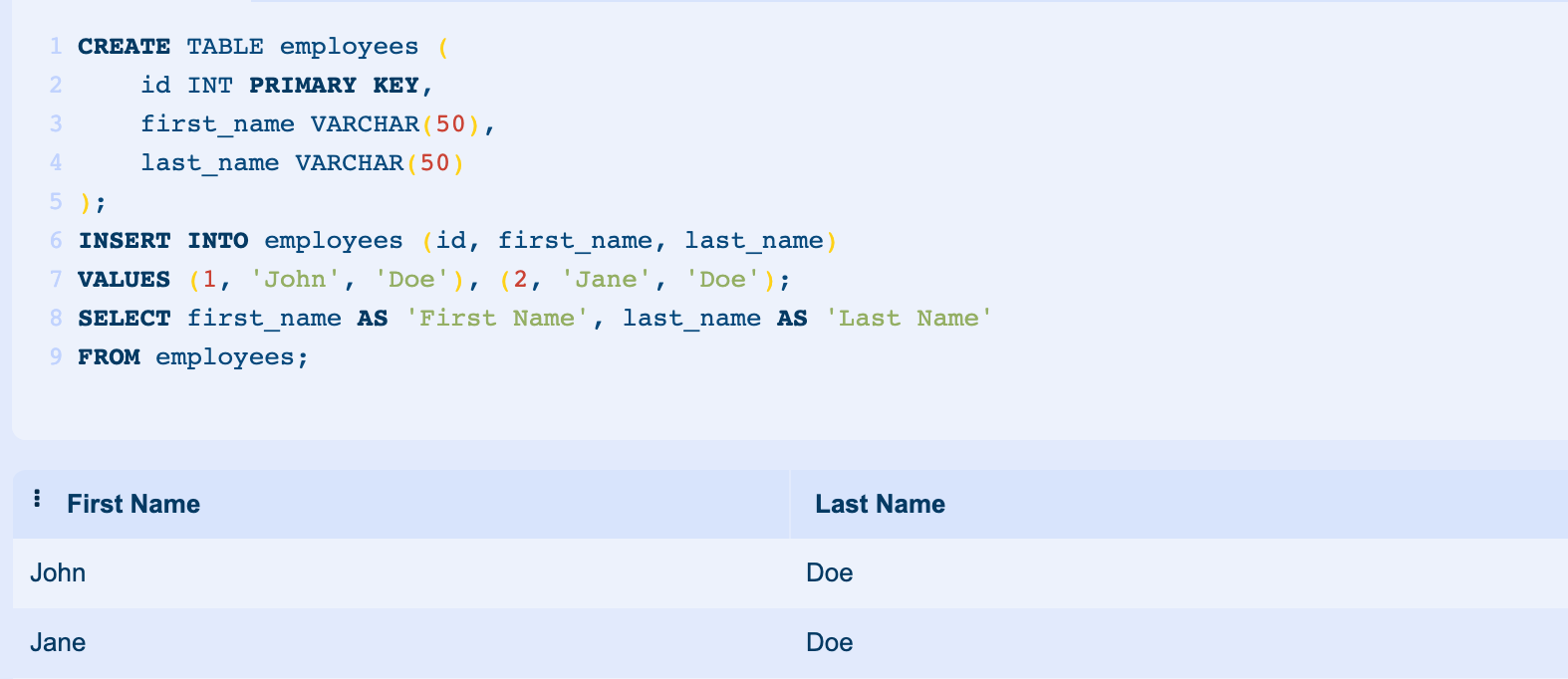
In this query, the SQL statement selects fields first_name and last_name which are then renamed to ‘First Name’ and ‘Last Name’ as aliases, respectively in the output as one table.
Note: Renaming is only valid within the context of the query and does not impact the actual database schema.
Once the query has been executed, the original column or table names remain unchanged in the database.
Now that we’ve gone over the basics, let’s take a look at some practical examples of the SQL AS statement in the next section.
6 Examples of SQL AS Statement in Queries

So far, we’ve talked about the AS statement in theory, but as they say, seeing is believing!
Let’s dive into some hands-on examples to truly grasp how this nifty tool works in real-life scenarios.
By the end of this section, you’ll be able to confidently use the AS statement in your own queries.
1. Column Aliasing
Column aliasing is one of the primary uses of the SQL AS statement.
When you give a column a temporary name for the duration of a query, you’re essentially creating a column alias.
This is particularly useful for making your query results more readable or for differentiating columns with similar names from different tables.
Imagine you have a table named employees with columns first_name and last_name.
You want to combine these two columns to get the full name of the employees in your query result. Here’s how you can use column aliasing to achieve this:
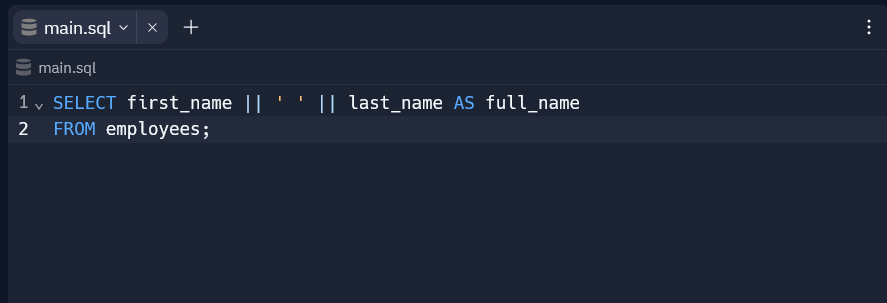
In this query, the expression first_name || ‘ ‘ || last_name combines the first and last names with a space in between.
The “AS” statement then assigns the alias full_name to this combined column in the output.
So, instead of seeing a column with no clear name, you’ll see a column named full_name in your results, making it immediately clear what the column represents.
2. Table Aliasing
Table aliasing is another essential application of the AS statement.
When you’re working with multiple tables, especially in JOIN operations, table aliasing can make your queries more concise and readable.
Table aliasing allows you to assign a temporary, usually shorter, name to a table within a specific query.
This is particularly beneficial when you’re working with tables that have long names or when you’re joining multiple tables and want to reference them more succinctly.
The actual table name in the database remains unchanged; the table alias is just a shorthand reference for the duration of the query.
Let’s say you have two tables: employee_details and department_details.
You want to join these tables to fetch the names of employees along with their respective department names.
Given the length of these table names, using them repeatedly in the query can make it lengthy and harder to read.
This is where table aliasing comes into play as you can see in the following query:

In this query:
- The employee_details table is aliased as e.
- The department_details table is aliased as d.
By using these aliases, the JOIN condition and the SELECT statement become much more concise.
Instead of writing out the full table names each time you reference a column, you can use the shorter table aliases, making the query both cleaner and easier to understand.
3. Aliasing Expressions or Calculated Fields
Aliasing is not just limited to columns and tables; it’s also invaluable when working with expressions or calculated fields.
When you derive new data from existing table columns using mathematical or string operations, or when you use built-in SQL functions, the result often doesn’t have a clear name.
Aliasing helps give a meaningful name to such derived data, making the output more understandable.
Imagine you have a table named sales with columns price and quantity.
You want to calculate the total cost for each item. Here’s how you can use aliasing for this calculated field:

In this query, the expression price * quantity calculates the total cost for each item.
Using the AS statement, we assign the alias total_cost to this calculated field.
As a result, the output will have a column named total_cost, making it immediately clear what the values represent.
4. Concatenating Columns
If you want to combine two or more columns and present them as a single column in your result set, you can use the AS keyword to alias the concatenated fields.
SELECT CONCAT(first_name, ' ', last_name) AS 'Full Name'
FROM employees;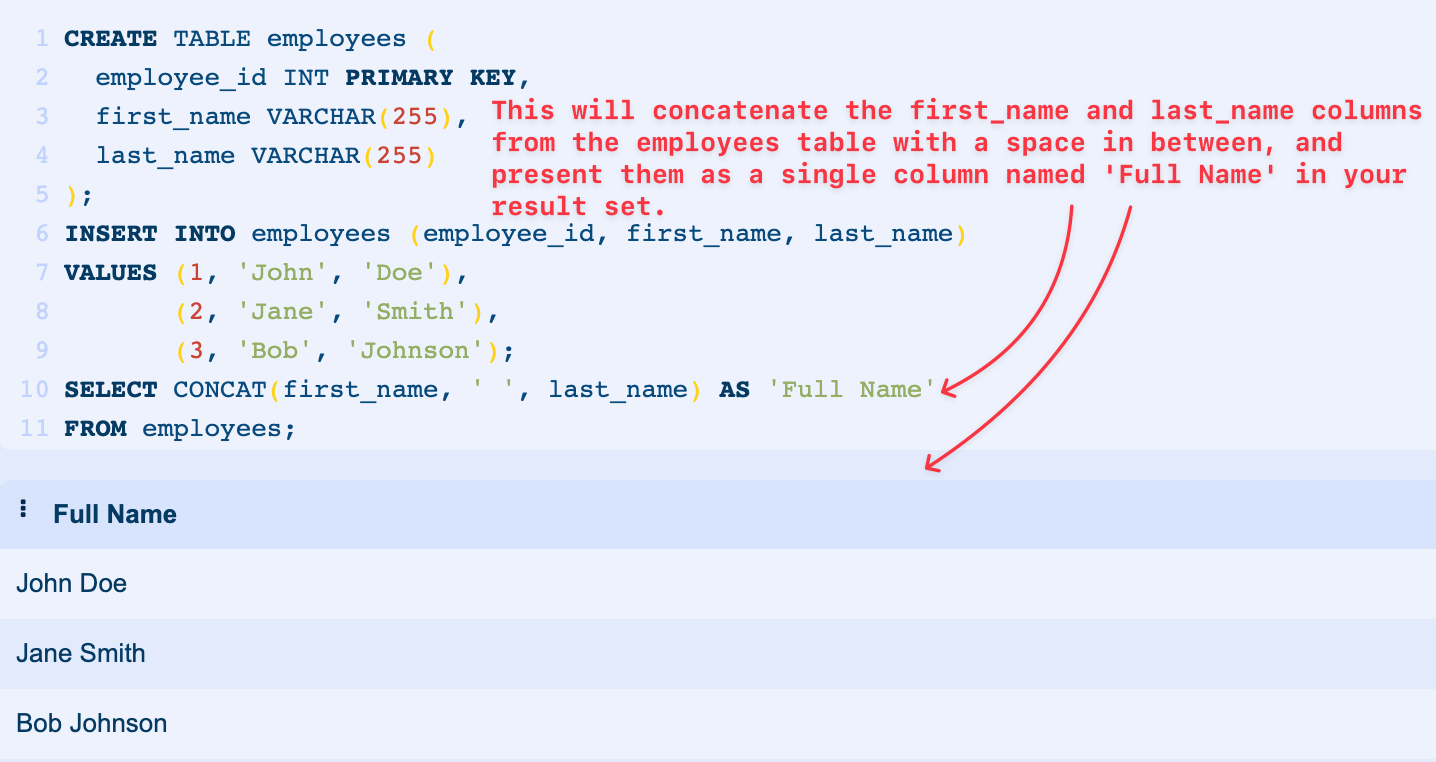
In this example, the ‘Full Name’ alias represents the combined first_name and last_name columns as the result set.
5. Using Aggregate Functions:
When using aggregate functions such as COUNT, SUM, AVG, etc., it’s common to use the AS keyword to provide a meaningful name to the calculated value.
SELECT COUNT(employee_id) AS 'Number of Employees'
FROM employees;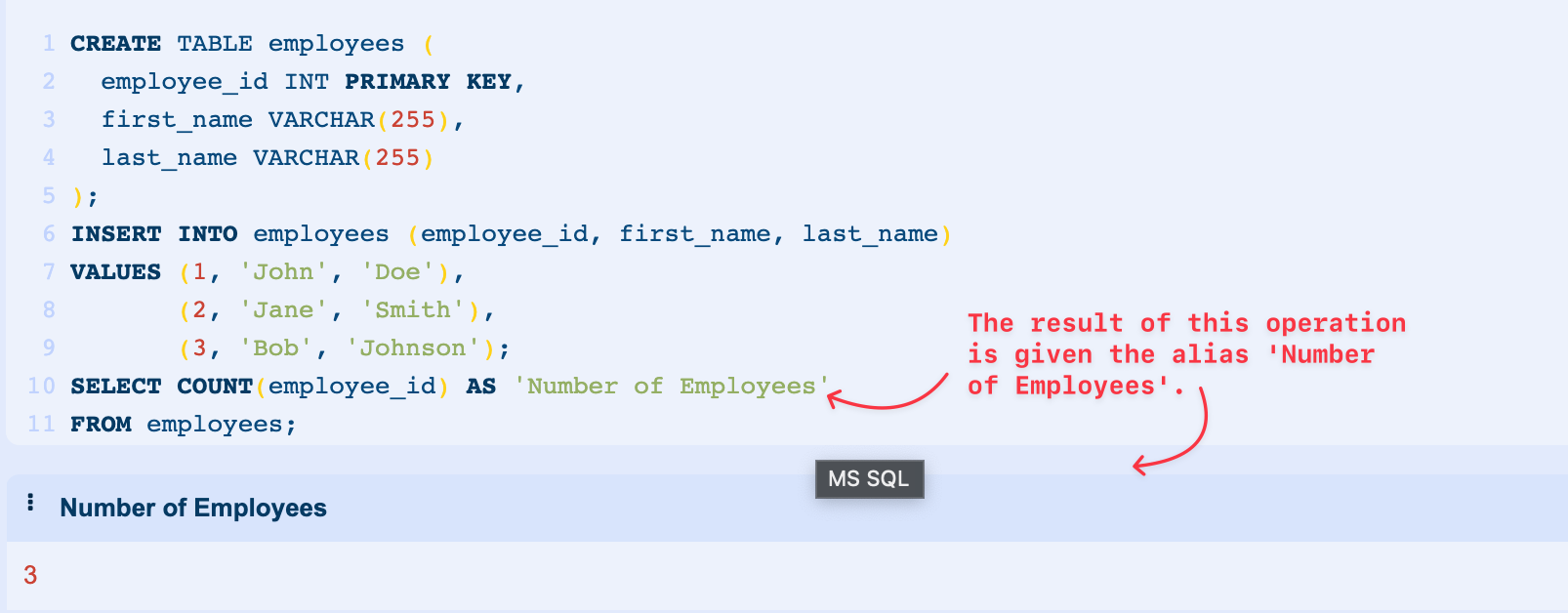
6. Complex Queries and Subqueries
In more complex queries or subqueries, using the AS keyword can significantly improve data readability and maintainability of your table name.
Here’s an example:
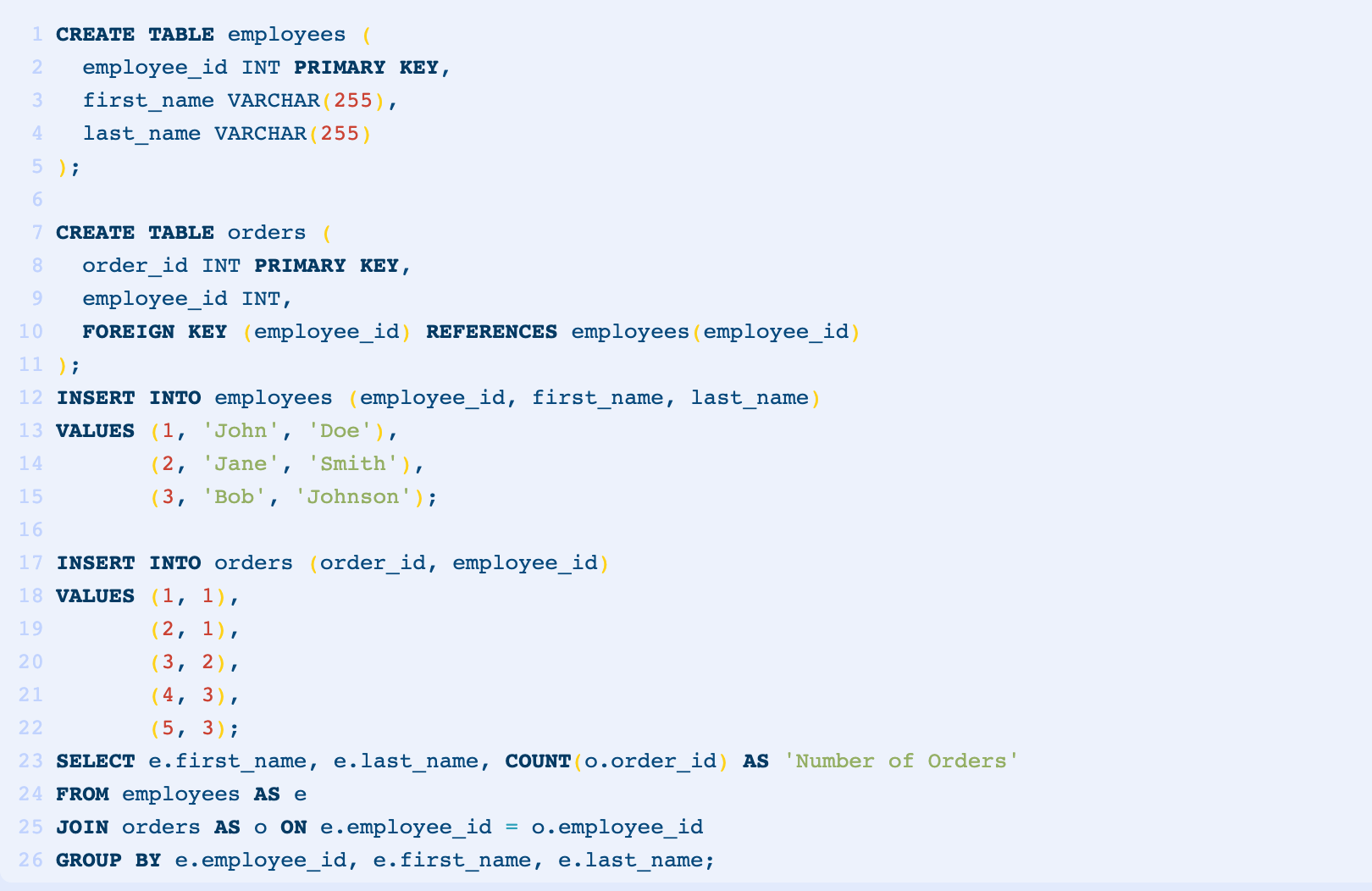
This selected the first and last names from the employees table, counted the number of orders for each employee in the orders table, and presented these counts as a single column named Number of Orders in the result set.
The AS function is used to alias the tables and the result of the COUNT function and only uses temporary names as column names.
Note: When using aggregate functions like COUNT, all columns in the SELECT list that aren’t aggregated should be included in the GROUP BY clause.
Common Mistakes and Best Practices When Using SQL AS Statement
The SQL AS statement, while straightforward, can sometimes be a source of confusion or errors, especially for those new to SQL.
Let’s explore some common pitfalls and best practices to ensure your queries are both efficient and error-free.
1. Forgetting the AS Keyword
Mistake: Sometimes, you might forget to include the AS keyword when aliasing.

Best Practice: Always use the AS keyword for clarity, even if some databases allow omission.
2. Using Reserved Words as Aliases
Mistake: Using SQL-reserved words as aliases can lead to confusing or erroneous queries.

Best Practice: Avoid using reserved words (select in the above example).
If you must, use double quotes or square brackets (based on the database system) around the alias.
3. Not Using Aliases in Complex Queries
Mistake: In JOIN operations or subqueries, not using aliases can make the query hard to read and maintain.
Best Practice: Always use table aliases in JOINs or when working with subqueries to make the query more readable and to avoid ambiguity.
4. Inconsistent Alias Naming
Mistake: Using different aliases for the same table or column in different parts of a query or across multiple queries.
Best Practice: Be consistent with your alias naming. If you’ve aliased a table as e for employees in one part of your application, try to stick with that convention.
5. Over-Aliasing
Mistake: Giving aliases to columns or tables when it’s not necessary can make a query harder to understand.
Best Practice: Use aliases purposefully. If a column or table name is short and clear, there might be no need to alias it.

6. Not Using Descriptive Aliases
Mistake: Using non-descriptive aliases like a, b, and c can make a query hard to understand.
Best Practice: While aliases should be concise, they should also be descriptive enough to convey meaning. For instance, emp is a better alias for employees than just e.
7. Ignoring Case Sensitivity
Mistake: Some databases are case-sensitive. Using different cases for actual names and aliases can lead to errors.
Best Practice: Be aware of the case-sensitivity rules of your specific database. If in doubt, always use the correct case for table and column names.
While the AS statement in SQL is a powerful tool for improving query readability and structure, it’s essential to use it judiciously and consistently.
By being aware of common mistakes and following best practices, you can ensure your SQL queries are both efficient and easily understandable.
Final Thoughts

Mastering the SQL AS statement is a key step toward becoming proficient in SQL. It’s a simple yet powerful tool that can significantly enhance the readability and efficiency of your SQL queries.
While it may seem straightforward, understanding the subtleties of the AS statement and its applications in column and table aliasing can take your SQL skills to the next level.
This will not only ensure your code is cleaner and easier to understand, but it also sets a solid foundation for tackling more complex SQL tasks in the future.
If you’d like to learn more SQL concepts, particularly how to use SQL in Power BI and DAX, check out the video playlist below:
Frequently Asked Questions
Is AS in SQL optional?
Yes, the AS keyword in SQL is optional.
It’s used for aliasing or renaming a table or a column, but you can create an alias without it.
For instance, both “SELECT column_name AS alias_name FROM table_name;” and “SELECT column_name alias_name FROM table_name;” are valid.
What is the difference between end AS and AS in SQL?
“AS” is used for aliasing and renaming a column or a table to make queries easier to read and understand.
For example:
SELECT column_name AS alias_name FROM table_name;On the other hand, “END AS” is typically used in CASE statements to signal the end of conditions and to define an alias for the result.
For example:
SELECT column_name, CASE WHEN condition THEN 'result1' ELSE 'result2' END AS alias_name FROM table_name;How to change alias name in SQL?
To change the alias name in SQL, you simply need to modify the alias in your SQL query.
The alias is temporary and only exists during the execution of the query. It doesn’t permanently change the table or column name in the database.
Here’s an example of changing an alias:
-- Original alias
SELECT column_name AS original_alias FROM table_name;
-- Changed alias
SELECT column_name AS new_alias FROM table_name;In the first query, original_alias is the alias for column_name. In the second query, the alias is changed to new_alias.
The actual column name in the database remains unchanged.








